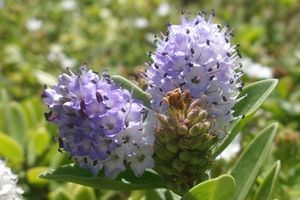 Hebe chathamica. Photo: John Sawyer.The flowering plants or angiosperms are the most diverse group of land plants and comprise about 90 percent of the plant kingdom with more than 250,000 different species. Except for extreme environments such as on high mountain tops or in the deepest oceans they occupy every habitat on Earth. Even Antarctica has two species of flowering plant - the hair grass (Deschampsia antarctica) and pearlwort (Colobanthus quitensis) which may be found around penguin colonies.
Hebe chathamica. Photo: John Sawyer.The flowering plants or angiosperms are the most diverse group of land plants and comprise about 90 percent of the plant kingdom with more than 250,000 different species. Except for extreme environments such as on high mountain tops or in the deepest oceans they occupy every habitat on Earth. Even Antarctica has two species of flowering plant - the hair grass (Deschampsia antarctica) and pearlwort (Colobanthus quitensis) which may be found around penguin colonies.
Flowering plants are critical to human survival and existence since they include the majority of the world’s food crops. Flowering plants also provide most natural clothing fibers and are the source of many kinds of medicines and timbers.
Flowering plants have a number of shared characteristics:
- Closed carpel enclosing the ovules i.e., a structure made up of an ovary, which encloses the ovules, and a stigma (where pollen germination occurs)
- Double fertilization, which leads to the formation of an endosperm (a nutritive tissue within the seed that feeds the developing plant embryo)
- Stamens with two pairs of pollen sacs
- Reduced female gametophyte
- Phloem tissue composed of sieve tubes and companion cells
Information is provided here about several groups of flowering plants:
For more infromation see:
- Angiosperms - Flowering Plants by Pam Soltis, Doug Soltis, and Christine Edwards. 2005.
